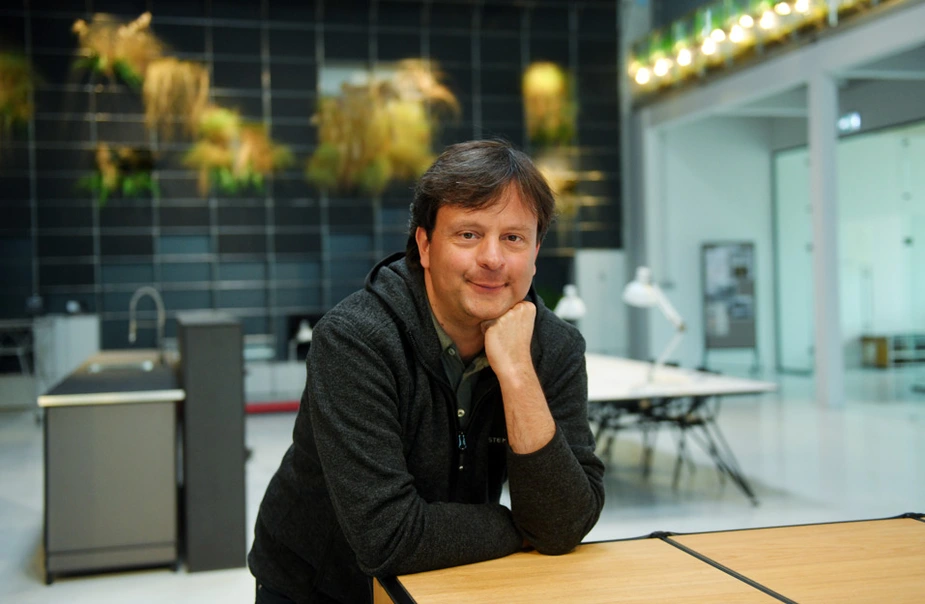Table 4.0
System 180 GmbH develops inspiring office environments
Agile work cultures in companies are key to master the diverse challenges of the digital age. Even large corporations are realising this. They are opening innovation labs, factories and hubs that foster creativity beyond traditional management methods. „We deliver the furniture for effective, self-organised and team-based work,” says Andreas Stadler, CEO of System 180.
This approach is not new, says Stadler. Organisational systems theory has been dealing with the concept of agility since the 1950s. Thirty-five years ago, the social philosopher Frithjof Bergmann stated: “Work is capable of supplying us with energy, we never dreamt of having.” In 1983, the American philosopher founded the first “Center for New Work” in Flint, the “vehicle city”. Agility means that companies anticipate changes and stay ahead of the competition. Instead of reacting to changes, they create innovation.
“Furniture for the agilisation of companies is a megatrend,” says Stadler, “and Germany is one of the key players.” Stadler’s company was among the vanguard of this trend. When Hasso Plattner, the founder of SAP, imported the concept of design thinking to Germany and founded his School of Design Thinking in Berlin, he wanted spaces and furniture customised to the requirements of creative team work: flexible, durable, mobile and individually adjustable. This resulted in the DT series in 2007 and decade-long cooperation with System 180. “We got amazing publicity,” Stadler says gladly, “because the top-level managers from many German corporations are trained there.” Further, Stadler is glad to have an ear to the ground regarding customer feedback, their wishes and ideas.
System 180 is a patented system that consists of stainless steel pipes that bring together universal functionality, timeless design and high-quality workmanship. Developed by the architect, designer, exhibition manager and master stage electrician Jürg Steiner in the early 1980s, and still manufactured in Berlin today, it opens up unlimited possibilities for furnishing spaces and creating architectural structures. The system has been widely used, sometimes in spectacular projects, including a 5000-square-metre temporary façade for the Tempelhof airport, an installation for the Zollverein Coal Mine Industrial Complex, and a 360-degree projection tunnel for the Kazakh pavilion at the Expo 2017. It is also the bedrock of stores and offices of numerous fashion companies all over the world. The products of System 180 have received many awards for design and quality, including the Red Dot Design Award and several iF Product Design Awards.
As an architect, Stadler would appreciate being more involved in architectural projects. “However,” he says, “the furniture business is far more relevant at the moment.” His company has started to combine its products, with their technical, lab-like, sometimes experimental style, with new materials like real wood, felt and lino.
His most recent endeavour – the ISM Hexadome at the Martin-Gropius-Bau in Berlin – is a home game for Andreas Stadler, a trip “back to my roots”, as he puts it. The listed former museum of applied arts was being refurbished in 1993 and was hidden behind the scaffolding. System 180 was commissioned to install ramps and canopies to advertise the ongoing exhibitions inside. “This was my first contact with System 180, when I started university,” Stadler remembers. Adding to his feeling of nostalgia is the fact that the exhibition was organised by a collective from Kreuzberg. When System 180 was founded in 1991, his first office was also in a courtyard in Kreuzberg. The ISM Hexadome is a dome-shaped lattice shell construction with a 15-metre diameter that fills the entire courtyard of the Gropius building. The six large screens at viewing height are surrounded by loudspeakers. Three subwoofers and 49 loudspeakers make the sound travel from side to side. Despite the number of speakers, the construction had to be sturdy but delicate. The speakers are used by nine different contemporary artists, among them Brian Eno, famous producer of U2, film score composer and co-founder of the band Roxy Music, who fill the space with sound. Moreover, the construction had to be light and easy to assemble. The exhibition as well as the dome will leave Berlin soon and travel to London and then to the US.
By Rico Bigelmann for Adlershof Journal
